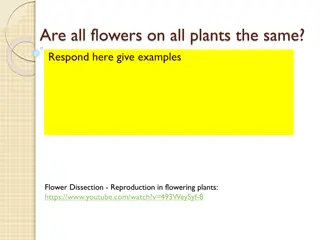Understanding Monocot Plants: Features and Families
Monocotyledon plants, a significant group of flowering plants, have unique characteristics such as adventitious roots, parallel-veined leaves, and flowers with parts in sets of three or four. The Poaceae family, including economically important grasses, and the Cyperaceae family, known as sedges, are notable monocot plant families. Cyperus rotundus is a specific example of a species within the Cyperaceae family. Explore the diversity and importance of monocot plants in ecosystems and human life.
Download Presentation

Please find below an Image/Link to download the presentation.
The content on the website is provided AS IS for your information and personal use only. It may not be sold, licensed, or shared on other websites without obtaining consent from the author. Download presentation by click this link. If you encounter any issues during the download, it is possible that the publisher has removed the file from their server.
E N D
Presentation Transcript
Kingdom: Plantae
Monocotyledon (monocot) Clade : One of the two great groups of flowering plants. There are approximately 60,000 species of monocots, including the most economically important of all plant families, Poaceae , Orchidaceae , Liliaceae.
.Characteristics of monocot 1- The roots are adventitious 2-The leaves are parallel-veined 3- Flowers of monocots most often have the parts in sets of three or four of the sepals and petal , but almost never five. 4-It has single cotyledon in the seed.
Order : Poales Family:(poaceae) Gramineae The Poaceae( Gramineae or true grasses) are the second larger family in Iraq and constitute the most economically important plant family in modern times, providing forage, building materials and fuel (ethanol), as well as food.
Order: Cyperales Family: Cyperaceae The Cyperaceae is one of monocots families which known also as sedges, this family is represented with some 5,500 species described in about 109 genera and 13 genera with 57 species in Iraq. sedges may be found growing in almost all environments, many are associated with wetlands, or with poor soils. Ecological communities dominated by sedges are known as sedgelands.























